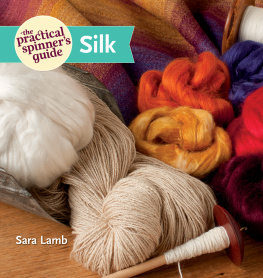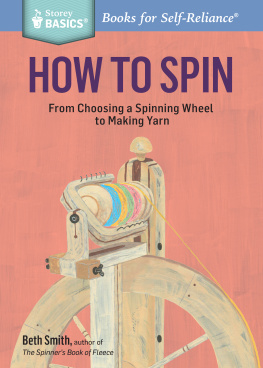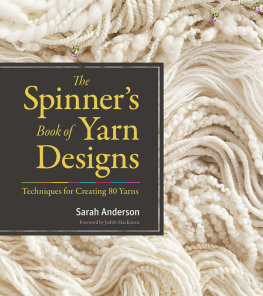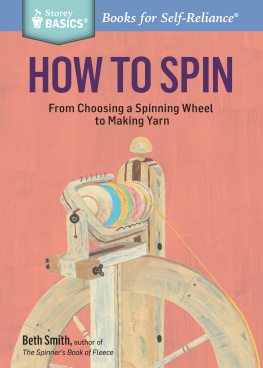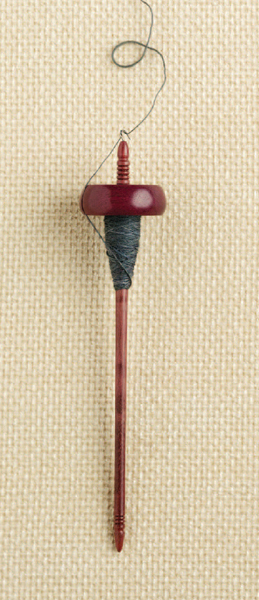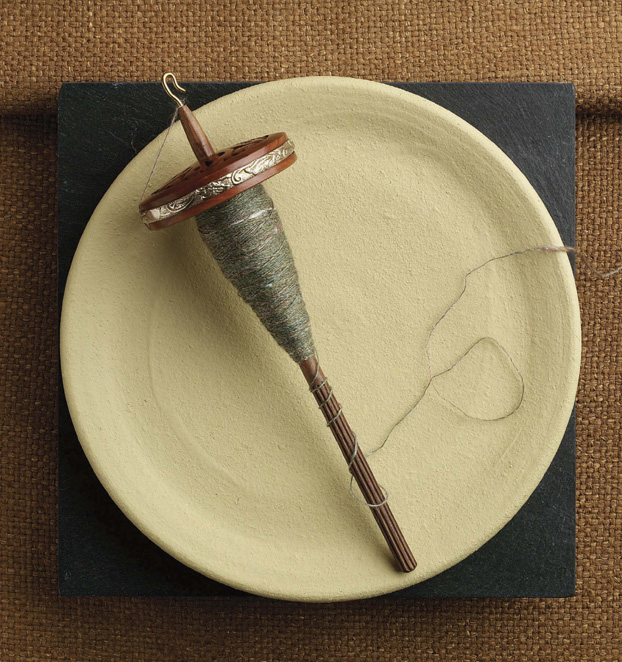All rights reserved.
Respect the spindle : spin infinite yarns with one amazing tool / Abby Franquemont.
p. cm.
Includes bibliographical references and index.
1. Hand spinning. 2. Spindle-whorls. I. Title.
Acknowledgments
Thank you first and foremost to my husband and son, whove endured seemingly endless talk about this book coupled with all manner of household disaster, and still love me as much as I love them. Anne Merrow, my fearless editor, was a true partner in making this book happen quickly and beautifully. I could not ask for a finer technical editor than Maggie Casey.
So many people helped in so many ways, like all the wonderful equipment makers who loaned or donated spindles and tools. Big thanks to Tom Forrester and Jonathan Bosworth for long conversations about spindle dynamics. My dear friend Denny McMillan was a godsend both behind the scenes and for sharing the cowl she made from her first spindle-spun yarns. Thanks to Faina Letoutchaia for everything shes taught me about Russian spindles. I couldnt have pulled this off without Beth Smith and Amy King, who pitched in in too many ways to number. Thanks also to the veteran authors who cheered me on and talked me down off ledges, like Judith MacKenzie McCuin and Stephanie Pearl-McPhee.
Thank you to everyone out there who said, You should write a book about spindles, and last but not least, to everyone at Interweave who agreed and the exceptional team who made it all happen.
Contents

Photo by Chris Franquemont
Since the early days of human history, spun fiber has been essential to the fabric of our lives. It fills needs so basic we cant imagine doing without them. It is the stuff of myth and legend; it is treasure beyond compare; it is commonplace and everyday. From a battered pair of favorite jeans to the carpet on our floors, and from the tents we take camping to delicate electronic components, we generally get our textiles in ready-to-use forms. They are simply there, provided for us by industry.
In the modern world, spinners have access to an incredibly broad range of tools and equipment. We can choose from every imaginable type of wheel, collect beautifully crafted spindles, and fill them with luscious fibers from all over the worldbut we can also choose simple tools we make ourselves, inexpensive and improvised solutions, secondhand and salvaged equipment.
When the Spindle Rules
I learned to spin in the rural Andes of Peru. I was five years old and already alarmingly behind the curve. The elder women in town set out to remedy this by giving me a spindlea low-whorl spindle, clunky and imperfectly balanced, weighing around 12 ounces (4560 grams). The spindle was made of a eucalyptus stick, smooth-whittled and more or less round, with a hand-carved wooden whorl. It was a typical spindle to give to a child, but adults used similar spindles for production work.
This isnt to say that some spindles werent better than others, or that nobody had favorites; some tools seem to be better or more comfortable than others. With use and wear, many break in and get better at being tools.
So do spinners. This is a key factor in the wheel vs spindle debate. How do Andean spinners produce fine, spindle-spun high-twist yarns in quantity, using only the humblest of tools? Practice. It becomes reflexive, instinctive. That doesnt happen overnightperhaps in years rather than weeks or monthsbut it does happen.
Growing Up Spinning
It took me over three years to become an adequate spinner. The year I was eight, my spinning was considered acceptable in quality by Andean standards (if slowly produced). Andean weavers require one type of yarn, fine and strong and smoothand they are exacting judges, so this was no small feat. By this age, most girls in my peer group were spinning yarn for the familys weaving supply. Others had shown particular gifts for spinning and produced yarns for some of the towns finest weavers.
The rest of us, the merely adequate young spinners, regarded these girls with mild awe. Although it might sound like wed spent our childhoods being sternly schooled in how to spin (and we had), our textile activities were our primary social outlet. We went out in the Inca ruins to pasture sheep, taking our spinning and weaving with us. We raced up and down hills and terraces, played tag, and gossiped. Spinning was one more game, even though we knew it was an important life skill. Those girls who were fast, perfect spinners at that age were like the girls who could sing or dance or run the fastest, only spinning was more important than that.
And we were competitive: we challenged each other to improve, constantly. By this time we were fearless with our spindles, which were never out of our hands unless we were weaving or eating. We spun while running, jumping, chasing sheep. We would pass spindles to each other while walking, talking, and spinning on them; we spun off the sides of Inca terraces, hearts pounding while the other girls watched, joking, chattering, saying, You cant do it! Its going to break! Youll be chasing that spindle all the way down the hill! The really good spinners never had to chase their spindles. As for me, it was a good thing I was one of the faster kids, because I chased my spindle a lot.
With these games and challenges and the strict standards of our elders, even the completely average spinners among us became capable of production spinning. It was simply part of our lifestyle, as commonplace and essential as tying shoes or talking on the phone are in the industrialized world. My spindle was an essential part of my Andean lifeof everyones. We were never without our spindles.
Enter the Wheel
Later that same year, back in the United States, I encountered my first spinning wheels. One was an antique Shaker-made great wheel my parents had found. This was the first wheel I learned to use and also the first type of wheel widely adopted by spinners who had spent thousands of years using spindles. Great wheels are the oldest and simplest of the lot: a large wheel that drives a horizontal spindle.



